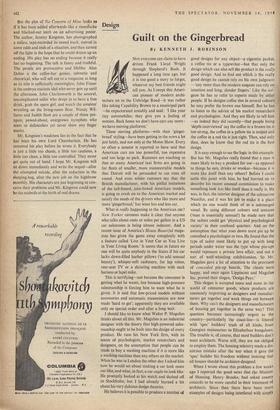Design
Guilt on the Gingerbread
By KENNETH J. ROBINSON Nu r everyone can claim to have driven Frank Lloyd Wright through Shepherd's Bush. It happened a long time ago, but it is too good a story to forget, whatever my best friends might tell you. As I swept this Ameri- can pioneer of modern archi- tecture on to the Uxbridge Road—it was rather like taking Capability Brown to a municipal park —he expectorated amiably and said : like your tiny automobiles; they give you a feeling of motion. Back home we don't have cars any more : we have moving platforms.'
These moving platforms—with their 'ginger- bread' styling—have been getting in the news a lot just lately, and not only at the Motor.Show. Every so often a senator is reported to have said that American cars are too powerful, too expensive and too large to park. Rumours are reaching us that so many American' taxi firms are going in for fleets of smaller, more manoeuvrable models that Detroit will be persuaded to cut sizes all round. And even wilder rumours say that the British manufacturer, with his pitiful imitations of the tail-finned, juke-boxed American models, is going to crash on to the American market and satisfy the needs of the drivers who like more and more `gingerbread,' but want less and less car.
What is really happening to the American car? New Yorker cartoons make it clear that anyone who talks about costs or miles per gallon in a US car salesroom is being almost indecent. And a recent issue of America's House Beautiful maga- zine has given the game away completely with a feature called 'Live in Your Car as You Live in Your Living Room.' It seems that in future no one will be quite anybody in the States if his car lacks down-filled leather pillows (`to add sensual beauty'), whisper-soft cashmere, fur lap robes, rear-seat TV or a dictating machine with neck harness or lapel mike.
This is terrifying—not because the consumer is getting what he wants, but because high-pressure salesmanship is forcing him to want what he is given. It is said that low-priced models without accessories and automatic transmission are now made `hard to get'; apparently they are available only on special order and after a long wait.
I should like to know what Walter P. Magulies thinks about all this. Mr. Magulies is an industrial designer with the theory that high-powered sales- manship ought to be built into the design of every product. He runs his New York firm, with its teams of psychologists, market researchers and designers, on the assumption that people can be made to buy a washing machine if it is more like a washing machine than any others on the market. When he was in London the other day I asked him how he would set about making a car look more car-like, and what, in fact, a car ought to look like. He promptly looked at his watch and dashed off to Stockholm, but I had already learned a lot about his very dubious design theories.
He believes it is possible to produce a number of good designs for any object—a' cigarette packet, a coffee tin or a typewriter—but that only the design which can also sell the product is the really good design. And to find out which is the really good design he cannot rely on his own judgment —`any more than the modern surgeon can rely on intuition and long, slender fingers.' Like the sur- geon he has to refer to reports made by other people. If he designs coffee tins in several colours he may prefer the brown one himself. But he has to listen to the advice of his market researchers and psychologists. And they are likely to tell him —as indeed they did recently—that people being `depth-interviewed' say the coffee in a brown tin is too strong, the coffee in a yellow tin is insipid and the coffee in a red tin is just right. Then, and only then, does he know that the red tin is the best design.
It is easy enough to see the logic in this example. But has Mr. Magulies really found that a man is more likely to buy a product for use—as opposed to things he eats, drinks or smokes—because it is more like itself than any others? Before I could settle this point with him, he had hurried on to describe his recent unusual commission to make something look less like itself than it really is. He was, in fact, the interior designer of the submarine Nautilus, and it was his job to make it a place which no one would think of as a submerged vessel. 13y using different colours and textures (`man is essentially sensual') he made sure that the sailors could get 'physical and psychological variety' in their confined quarters. And on the assumption that what goes down must pin up he consulted a psychologist or two. He found that the type of sailor most likely to put up with long periods under water was the type whose pin-ups would represent a private love affair, and not a sort of wolf-whistling exhibitionism. So Mr. Magulies gave a lot of attention to the provision of concealed pin-up boards. The clients were happy, and once again Lippincott and Magulies Inc. proved their slogan, 'Design Pays.'
This slogan is accepted more and more in the world of consumer goods, where products are constantly improving as designers and manufac- turers get together and work things out between them. Why can't the designers and manufacturers of housing get together in the same way? This question becomes increasingly urgent as the country—particularly the coast-line—is littered with 'spec' builders' trash of all kinds, from Georgian maisonettes to Elizabethan bungalows. The trouble is, of,course, that most builders don't want architects. Worse still, they are not obliged to employ them. The housing ministry made a dis- astrous mistake after the war when it gave the `spec' builder his freedom without insisting that all houses should be architect-designed.
When I wrote about this problem a few weeks ago I reported the good news that the Minister of Housing, Henry Brooke, had asked county councils to be more careful in their treatment of architects. Since then there have been more examples of designs being interfered with simplY because lay committees did not like the look of the elevations. The other day a pleasant house designed for a rather expensive estate in Surrey was `esthetically controlled' out of existence by both the borough council and the Housing Minister on the grounds that it didn't fit in with the charac- ter of the large, but by no means beautiful, houses near by. One argument used was that it would be possible to mistake the house (my dear!) for a small block of flats. Very soon the Minister will be deliberating on an excellent housing scheme prepared for the Vale of Health, Hampstead, by a distinguished architect, Erno Goldfinger. The Minister felt so strongly about this case that he called the application in, which means that he has the right to make a decision about it by himself when he has considered a report on this week's public inquiry.
While .Mr. Brooke is making up his mind he might like to be reminded that in 1937, when he was secretary of a Hampstead preservation society, he protested strongly—and without success— against the same architect's scheme for housing in the same district. This scheme is, in fact, recog- nised as one of Hampstead's most interesting con- tributions to modern architecture.
It is absurd that ministerial time should be wasted on ponderous consideration of the work of professional men, when so much unprofessional and outrageously bad stuff is being built. What can be done about it? Should planning committees be abolished for a trial period? That was the sug- gestion made last week by Basil Spence, in his inaugural address as president of the Royal Insti- tute of British Architects. It is not, I think, a good suggestion. What we want is the removal of (esthetic control by these committees. (Much of their other important work should continue.)







































 Previous page
Previous page